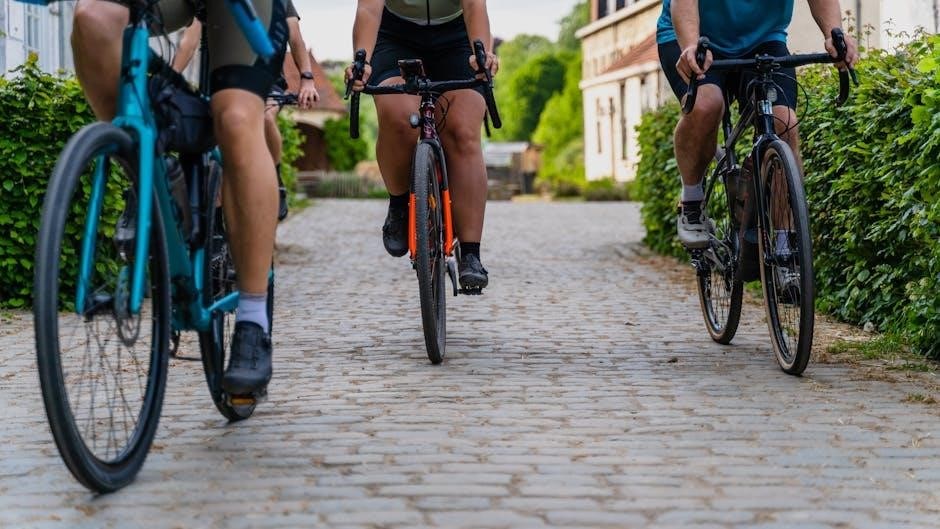Self-guided cycling trips offer a unique blend of freedom and adventure, allowing cyclists to explore destinations at their own pace without a structured group or tour leader.
1.1 What Are Self-Guided Cycling Trips?
Self-guided cycling trips are independent adventures where cyclists plan and execute their journey without a tour group or leader. These trips allow riders to explore destinations at their own pace, using tools like RideWithGPS and Komoot for route planning. Cyclists can download routes, track data, and incorporate points of interest, making the experience highly customizable. This style of travel appeals to those who enjoy flexibility and autonomy, enabling them to immerse themselves in local cultures and landscapes without rigid schedules. Self-guided trips also foster a sense of accomplishment and connection to nature, making them ideal for cyclists seeking a balance of adventure and personal growth. The ability to manage routes and data through apps like Strava further enhances the experience, allowing riders to focus on their journey and well-being.
1.2 Benefits of Self-Guided Tours
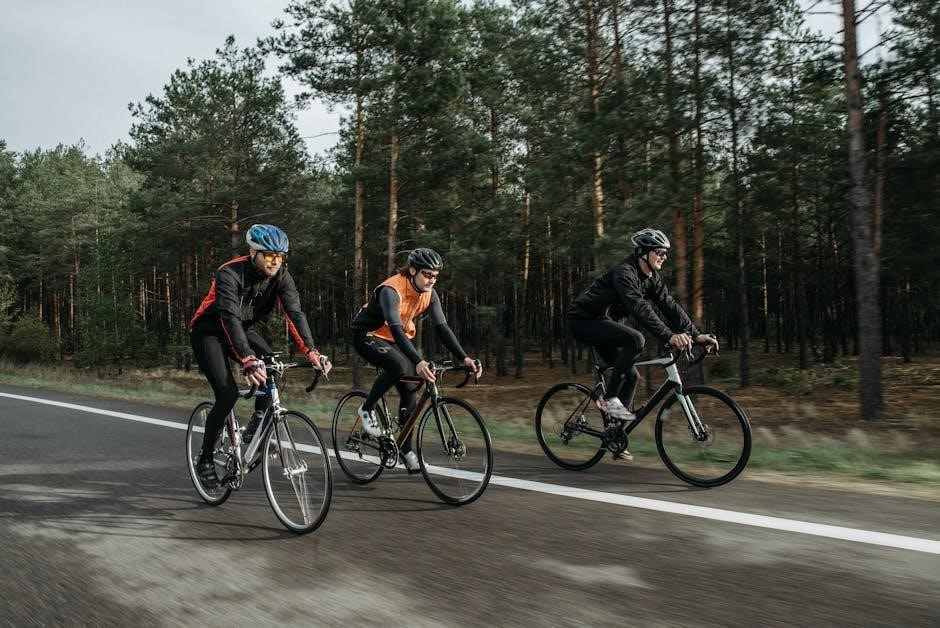
Self-guided cycling tours provide unparalleled flexibility, allowing cyclists to tailor their experiences to personal preferences and pacing. Riders can explore diverse landscapes and cultures at their own rhythm, fostering a deeper connection with their surroundings. These tours are often more cost-effective than guided options, as cyclists avoid the expenses associated with group tours. Additionally, self-guided trips encourage independence and self-reliance, enhancing mental well-being and confidence. Tools like Komoot and Strava enable riders to plan routes, track progress, and analyze data, making the experience both efficient and rewarding. The freedom to adjust plans on-the-go also allows cyclists to incorporate spontaneous discoveries, adding an element of adventure. Furthermore, the ability to share routes and data with others through platforms like Komoot and Strava creates a sense of community, even while traveling independently. This style of travel is ideal for those seeking a balance of autonomy, exploration, and personal growth.
1.3 Who Should Consider Self-Guided Trips?
Self-guided cycling trips are ideal for individuals who value independence and flexibility. Experienced cyclists who are comfortable with route planning and navigation will find these trips rewarding. They suit those who enjoy exploring at their own pace, whether that means taking leisurely stops or challenging climbs. Additionally, self-guided tours are perfect for travelers seeking a cost-effective option, as they eliminate the expenses of guided services. Cyclists who appreciate the freedom to adjust their itinerary based on personal preferences or spontaneous discoveries will thrive. These trips also cater to those who enjoy using technology, such as Komoot and Strava, for planning and tracking their rides. Furthermore, self-guided tours are suitable for cyclists who prioritize mental well-being, as the solitude and accomplishment of navigating independently can enhance their overall experience. This style of travel is particularly appealing to adventure-seekers and those looking to connect deeply with their surroundings.

Planning and Preparation
Effective planning ensures a smooth and enjoyable self-guided cycling experience, covering destination selection, route mapping, budgeting, and packing essential gear for varying terrain and weather conditions.
2.1 Choosing a Destination
Choosing the right destination for your self-guided cycling trip is crucial. Consider factors like terrain, climate, and points of interest to match your preferences and skill level. Popular regions often offer well-marked bike paths, scenic routes, and cyclist-friendly accommodations. Research local cycling culture, road safety, and seasonal weather patterns to ensure a smooth journey. For instance, Europe offers diverse options from flat countryside to mountainous trails, while regions like New Zealand provide stunning natural landscapes. Utilize online resources and cycling communities to gather insights and recommendations; Selecting a destination that aligns with your goals and abilities will enhance your overall experience and make your trip more enjoyable and stress-free. Proper planning and research are key to making the most of your adventure.

2.2 Route Selection and Mapping Tools (e.g., RideWithGPS, Komoot)
Route selection and mapping tools like RideWithGPS and Komoot are essential for planning self-guided cycling trips. These platforms allow users to search for routes, apply specific filters, and download maps for offline use. RideWithGPS offers detailed elevation profiles, turn-by-turn directions, and the ability to customize routes based on terrain and points of interest. Komoot, on the other hand, excels at suggesting scenic and bike-friendly paths, with features like route planning, live tracking, and voice navigation. Both tools integrate seamlessly with GPS devices, making navigation straightforward. By leveraging these resources, cyclists can create tailored itineraries, explore new regions confidently, and ensure a smooth journey. These tools are invaluable for both experienced cyclists and newcomers, providing the flexibility and precision needed for a successful self-guided adventure.
2.3 Budgeting and Cost Management
Budgeting and cost management are crucial for self-guided cycling trips, as they allow travelers to optimize expenses and enjoy a cost-effective adventure. Unlike guided tours, self-guided trips often save money by eliminating the costs of a tour leader and group logistics. Travelers can allocate their budget to accommodation, food, transportation, and gear, tailoring expenses to their preferences. Budgeting tools like spreadsheets or apps can help track spending, ensuring financial stability throughout the trip. Additionally, planning ahead for accommodation and meals can reduce daily costs, while cooking meals instead of dining out further saves money; Emergency funds should also be included to cover unexpected expenses, such as bike repairs or medical needs. By carefully managing resources, cyclists can enjoy a fulfilling and affordable self-guided cycling experience.
2.4 Essential Gear and Equipment
Proper gear is vital for a successful self-guided cycling trip. A durable, lightweight bicycle is the foundation, with options like road bikes, mountain bikes, or touring bikes depending on the terrain. Essential accessories include a comfortable saddle, puncture-resistant tires, and reliable brakes. Navigation tools such as GPS devices or smartphone apps like RideWithGPS or Komoot are indispensable for route planning. A well-fitted helmet is a must for safety, and reflective clothing enhances visibility. Carry a basic toolkit, spare tubes, and a pump to handle minor repairs. Hydration and storage are key, so water bottles, a hydration pack, and panniers or bikepacking bags are recommended. Weather-appropriate clothing, including waterproof jackets and layers, ensures comfort in varying conditions. Finally, a portable phone charger and a first-aid kit are crucial for emergencies. Ensuring all gear is in good condition and tailored to the trip’s demands will enhance the overall experience.
2.5 Physical Conditioning and Training
Physical conditioning is crucial for a self-guided cycling trip, ensuring you can handle the demands of the journey. Start training well in advance to build endurance, strength, and flexibility. Focus on gradual progression, increasing mileage and intensity over time to avoid burnout or injury. Incorporate a mix of on-bike training and off-bike exercises, such as core work and stretching, to improve overall fitness. Pay attention to cadence and pacing to maintain efficiency. Avoid common training myths, such as overtraining, which can hinder progress. Listen to your body and include rest days to allow for recovery. Aim to simulate the conditions of your trip during training, whether it’s climbing hills or riding on varied terrain. Proper conditioning will enhance your enjoyment and confidence on the road.
2.6 Safety Considerations and Emergency Planning
Safety is paramount on self-guided cycling trips, requiring careful planning and preparation. Always carry essential items like a first-aid kit, spare tires, and a basic toolkit. Ensure your bike is in good condition before departure. Plan your route to avoid unsafe areas and check for potential hazards like road closures or extreme weather. Carry a fully charged phone and consider a portable charger to stay connected. Wear reflective or high-visibility clothing to increase your visibility to drivers. Familiarize yourself with basic bike repairs and know how to handle emergencies like punctures or mechanical failures. Share your itinerary with a trusted contact and establish a communication plan. Be mindful of your surroundings and trust your instincts to avoid risky situations. Proper preparation and awareness can significantly reduce risks and ensure a safe, enjoyable journey.
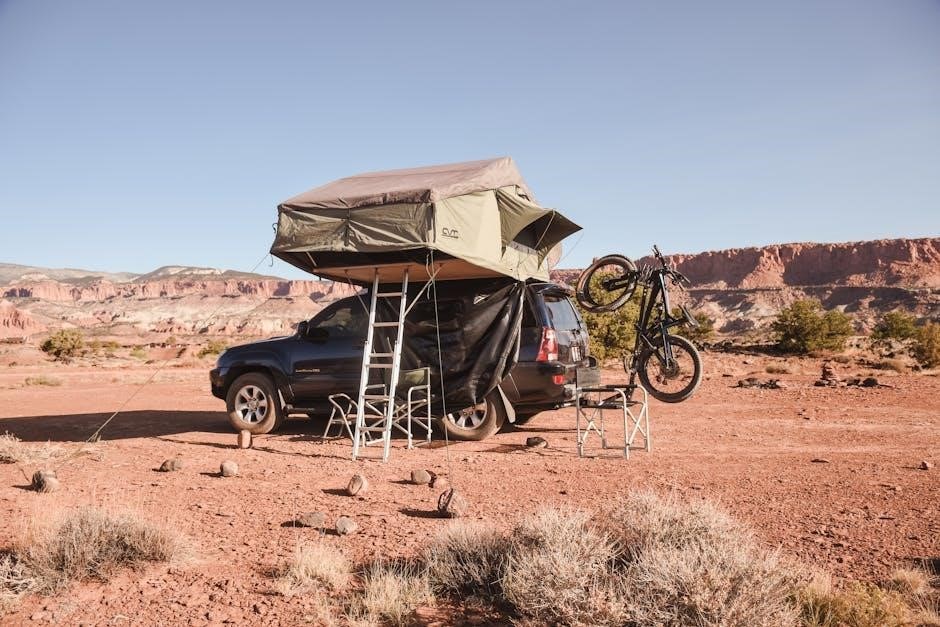
Route Planning and Navigation
Effective route planning ensures a smooth cycling experience, using tools like RideWithGPS and Komoot for detailed maps and navigation. GPS devices and apps help cyclists stay on track.
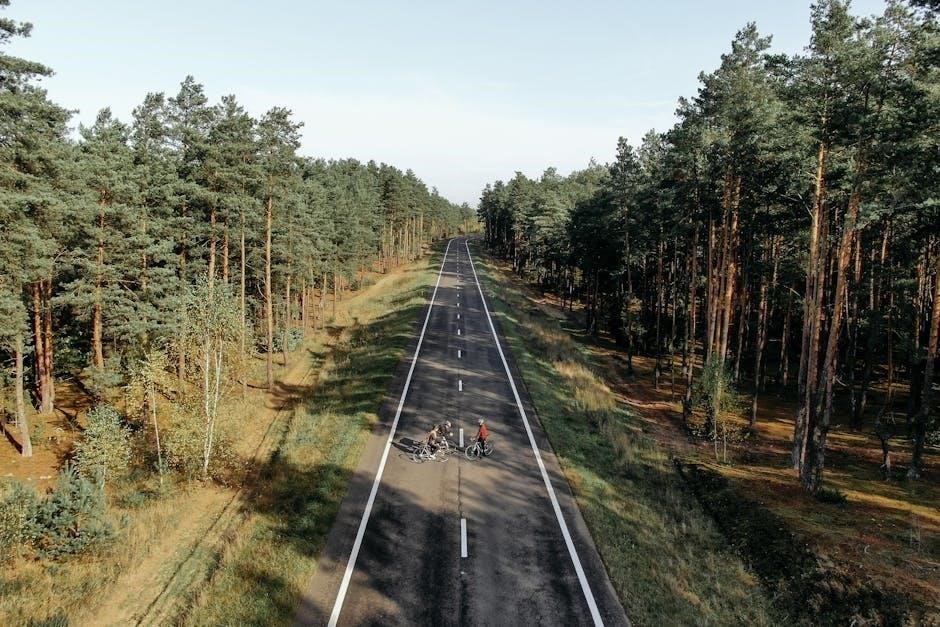
3.1 Using GPS Devices for Navigation
GPS devices are indispensable for self-guided cycling trips, offering precise route tracking and real-time navigation. Cyclists can download routes from platforms like Komoot or RideWithGPS directly to their GPS units, ensuring they stay on course. These devices often feature turn-by-turn directions, elevation profiles, and points of interest, enhancing the riding experience. Many modern GPS devices also integrate with smartphone apps, allowing for seamless data transfer and live updates. Additionally, they provide valuable metrics such as speed, distance, and heart rate, helping cyclists monitor their performance. For those venturing into areas with limited mobile coverage, GPS devices are particularly reliable, offering navigation without internet dependency. Overall, they empower cyclists to explore confidently, making self-guided tours more accessible and enjoyable.
3.2 Downloading and Managing Routes
Downloading and managing routes is a crucial step in planning self-guided cycling trips; Platforms like Komoot and RideWithGPS allow users to create, customize, and download routes tailored to their preferences. Cyclists can input start and end points, add waypoints, and adjust settings to avoid busy roads or include scenic paths. Once routes are finalized, they can be downloaded in formats compatible with GPS devices or smartphone apps. Managing routes involves organizing them into collections or folders, making it easier to access them during trips. Additionally, many platforms enable syncing routes to cloud storage, ensuring they are readily available across devices. For group trips, routes can be shared with fellow cyclists, promoting seamless navigation. Proper route management also includes regular updates to reflect changes in road conditions or points of interest, ensuring a smooth and enjoyable journey.
3;3 Incorporating Points of Interest
Incorporating points of interest into your self-guided cycling trip enhances the overall experience by allowing you to explore notable landmarks, scenic viewpoints, and cultural attractions. Using apps like Komoot and RideWithGPS, you can search for and add these points directly to your route. Prioritize them based on proximity, popularity, or personal interest to ensure a balanced itinerary. When downloading routes to a GPS device, ensure that these points are included, so you receive alerts as you approach them. Managing battery life is crucial, so consider carrying a portable charger, especially if using a smartphone for navigation. Balance is key—avoid overcrowding your route with too many stops, and categorize points as must-see or optional. Allocate time slots for each attraction to maintain pace, and document your visits with photos or notes for lasting memories. This approach ensures an enriching and organized journey.
Accommodation and Logistics
Accommodation and logistics play a vital role in self-guided cycling trips, ensuring a smooth journey. Plan lodging in advance or spontaneously, and organize luggage transport efficiently for convenience.
4.1 Types of Accommodation for Cyclists
Cyclists on self-guided trips have various accommodation options to suit their preferences and budgets. Hotels and bed-and-breakfasts offer comfort and amenities, while budget-friendly hostels provide a social atmosphere. Camping is ideal for those seeking immersion in nature, often with basic facilities. Many cyclists prefer guesthouses or Airbnb rentals for a home-like experience. Additionally, bike-friendly hotels cater specifically to cyclists, offering services like secure bike storage and maintenance facilities. Some regions also provide unique accommodations, such as eco-lodges or farm stays, enhancing the cultural experience. Choosing the right accommodation ensures a restful stay and prepares cyclists for the next day’s adventure. Proper research and booking in advance are crucial to secure suitable options, especially during peak travel seasons.
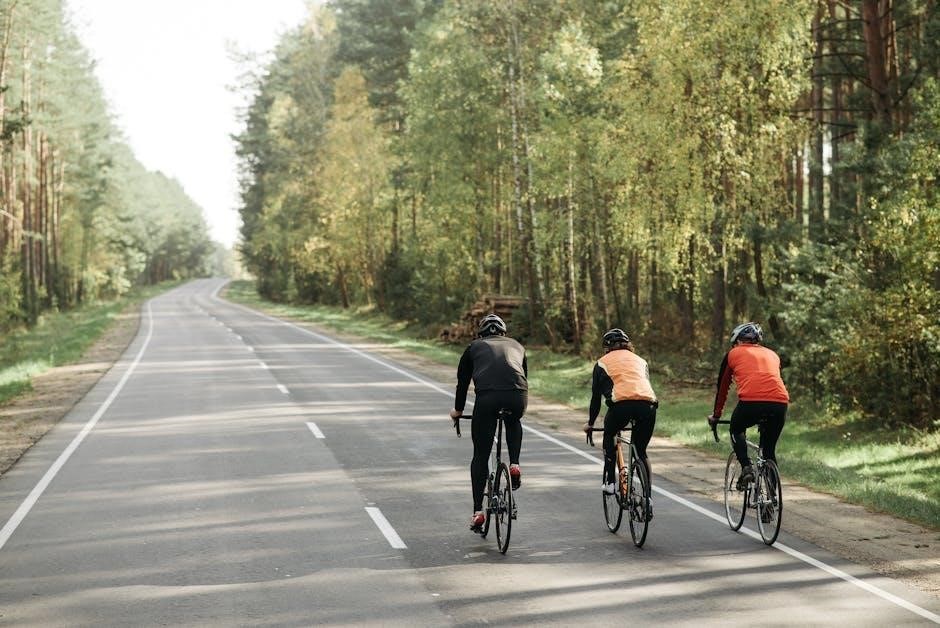
4.2 Booking in Advance vs. On-the-Go
Booking accommodation in advance versus arranging it on-the-go depends on the cyclist’s preferences and the trip’s nature. Advance booking ensures availability, especially in popular destinations or during peak seasons, and helps in budgeting. It also allows cyclists to research and choose bike-friendly options with amenities like secure storage. On-the-go booking offers flexibility, ideal for spontaneous changes in plans or unpredictable schedules. However, it risks limited availability, particularly in busy areas. Cyclists can use apps like Airbnb, Booking.com, or Hostelworld for last-minute options. A hybrid approach—booking key stops in advance while leaving room for spontaneity—often works best. Additionally, carrying a list of potential accommodations or using local tourist information centers can ease on-the-go planning. Balancing flexibility and security is key to a stress-free cycling experience.
4.3 Transportation of Luggage
Transporting luggage on self-guided cycling trips requires careful planning to ensure a smooth journey. Cyclists often use panniers or bikepacking bags attached to their bikes, allowing them to carry essentials like clothing, tools, and snacks. For longer trips, some opt for luggage shuttle services, where bags are transferred to the next accommodation ahead of time. This minimizes the weight carried on the bike and reduces fatigue. Additionally, many cyclists plan their routes to include stops with convenient storage options or use public transportation for sections where carrying luggage isn’t practical. Investing in lightweight, durable gear and organizing the load efficiently are crucial for maintaining balance and comfort while riding. Furthermore, using online platforms or apps to book accommodations with bike storage can help in managing luggage effectively. Testing the luggage setup before the trip ensures everything works well, and traveling light can enhance the sense of freedom and flexibility that self-guided trips offer. Proper luggage management not only prevents physical strain but also allows cyclists to fully enjoy the scenic views and cultural experiences along their route
Health and Wellness
Cycling on self-guided trips offers numerous mental health benefits, including reduced stress, improved mood, and enhanced overall well-being. The physical activity stimulates endorphins, which act as natural mood elevators. Exposure to nature and scenic landscapes further contributes to a sense of calm and relaxation. The freedom to explore at one’s own pace fosters a feeling of independence and accomplishment, boosting self-esteem. Additionally, the repetitive motion of cycling can be meditative, helping to clear the mind and reduce anxiety. Studies show that regular cycling can even alleviate symptoms of depression and anxiety by promoting mindfulness and providing a healthy distraction from daily worries. Overall, self-guided cycling trips provide a holistic approach to mental health, combining physical exercise with the joy of discovery and personal growth.
5.2 Managing Physical Fatigue
Managing physical fatigue is essential for enjoying self-guided cycling trips. Cyclists often face the challenge of balancing daily miles with their physical limits. To avoid burnout, it’s crucial to pace oneself and incorporate rest days. Proper training before the trip helps build endurance, while listening to your body ensures you don’t overexert. Nutrition plays a significant role; consuming balanced meals and staying hydrated keeps energy levels steady. Light stretching and cool-down exercises after rides can reduce muscle soreness. Additionally, avoiding common training myths, such as overtraining, is vital to maintain performance. By prioritizing recovery and adjusting your itinerary as needed, you can enjoy the journey without physical strain. Remember, the goal is to savor the experience, not to push beyond your limits.
5.3 Nutrition and Hydration Strategies
Nutrition and hydration are critical for maintaining energy and performance during self-guided cycling trips. A balanced diet rich in carbohydrates, proteins, and fats provides sustained energy, while avoiding heavy meals before rides prevents discomfort. Staying hydrated is essential, especially in hot conditions, as dehydration can quickly lead to fatigue. Cyclists should drink water regularly during rides and consider electrolyte-rich beverages to replenish lost salts. Snacking on energy bars, fruits, or nuts every 20-30 miles helps maintain blood sugar levels. Meal planning and packing lightweight, nutrient-dense foods are practical strategies for long rides. Proper nutrition not only enhances endurance but also supports recovery, ensuring you can enjoy the next day’s adventure without stiffness or exhaustion. By prioritizing nutrition and hydration, cyclists can optimize their physical performance and overall enjoyment of the trip.
Technology and Apps
Technology and apps like RideWithGPS, Komoot, and Garmin enhance self-guided cycling trips by providing route planning, navigation, and performance tracking, while ensuring privacy settings protect user data.
6.1 Cycling Apps for Route Planning (Komoot, Strava)
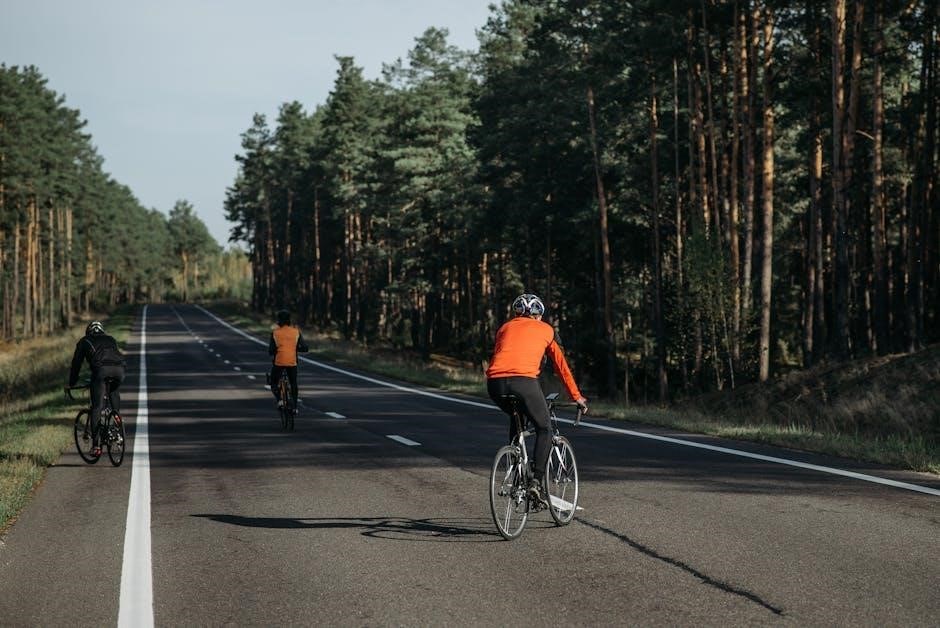
Cycling apps like Komoot and Strava are indispensable tools for self-guided cycling trips, offering robust route planning and navigation features. Komoot allows users to create detailed, customizable routes with elevation profiles and points of interest, which can be downloaded for offline use. Strava, while primarily known for tracking workouts, also provides route planning capabilities and connects cyclists to a community for inspiration and shared knowledge. Both apps integrate seamlessly with GPS devices, enabling cyclists to navigate effortlessly during their trips. These platforms empower cyclists to explore new territories confidently, making self-guided tours more accessible and enjoyable. By leveraging these apps, cyclists can focus on the adventure while leaving the logistics to technology.
6.2 Tracking and Analyzing Ride Data
Tracking and analyzing ride data is a crucial aspect of self-guided cycling trips, helping cyclists monitor their performance and progress. Apps like Strava and Garmin Connect enable riders to record metrics such as distance, speed, elevation gain, and heart rate, providing valuable insights into their workouts. These tools allow cyclists to set goals, track improvements over time, and compare rides for a deeper understanding of their abilities. Detailed analytics can also highlight areas for improvement, such as pacing or endurance, which can inform training strategies. Additionally, ride data can be shared with coaching platforms or fitness apps to gain personalized recommendations. By leveraging this information, cyclists can optimize their training and enhance their overall cycling experience, making every trip more rewarding and aligned with their fitness objectives.
6.3 Privacy Settings for Shared Routes
Privacy settings for shared routes are essential for cyclists who want to control how their rides are viewed and accessed by others. Platforms like Komoot offer detailed privacy options, allowing users to decide who can see their saved routes, activities, and collections. For instance, cyclists can choose to share routes publicly, with friends, or keep them entirely private. These settings ensure that sensitive information, such as favorite trails or training routes, remains secure. Additionally, privacy features like limiting who can follow you or find you on the platform add an extra layer of control. This is particularly important for cyclists who prefer to maintain anonymity or protect their personal riding habits. By adjusting these settings, cyclists can strike a balance between sharing their achievements and safeguarding their privacy, making self-guided cycling trips more enjoyable and stress-free.
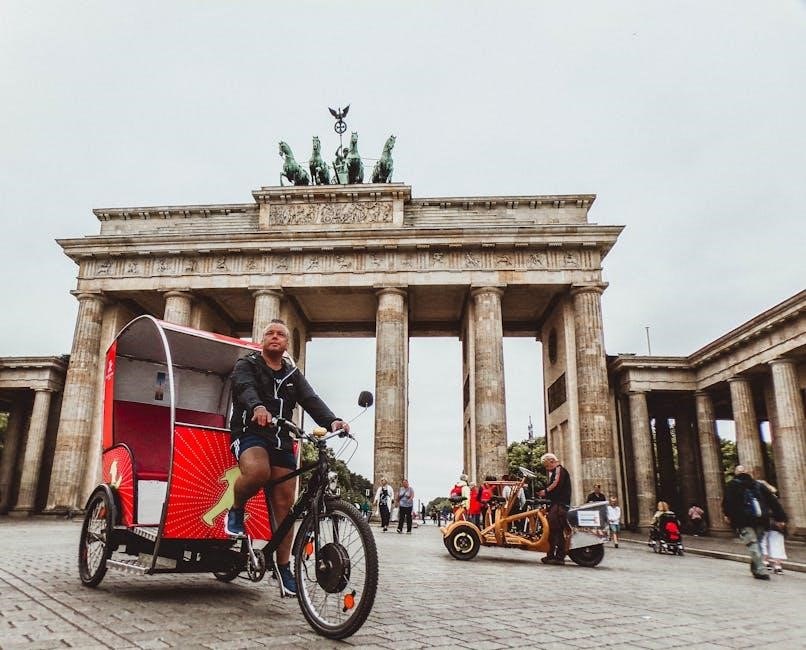
Post-Trip Activities
Post-trip activities involve documenting your journey, sharing experiences online, and reflecting on your adventure to preserve memories and inspire others. This step enhances the overall cycling experience.
7.1 Documenting Your Journey
Documenting your self-guided cycling trip is a great way to preserve memories and share experiences with others. Using apps like Strava or Komoot, you can track your routes and analyze ride data. Photographs and videos capture scenic highlights and personal moments, while journals or blogs provide a deeper reflection on your adventure. Many cyclists organize their documentation into scrapbooks or digital portfolios, creating a lasting record of their journey. Additionally, sharing your documentation on social media or cycling forums connects you with a community of enthusiasts, inspiring others to embark on similar trips. Proper organization and storage of your documentation ensure it remains accessible for future reference or storytelling. By documenting your journey, you not only relive the experience but also contribute to the cycling community’s collective knowledge and inspiration.
7.2 Sharing Experiences Online
Sharing your self-guided cycling trip experiences online allows you to connect with fellow cyclists and inspire others. Platforms like Strava, Komoot, and social media sites are ideal for posting route details, photos, and stories. By uploading your rides to Strava, you can share achievements and compete with others. Komoot enables you to post routes and tips, helping others plan their trips. Instagram and Facebook are great for showcasing highlights through photos and videos. Many cyclists also maintain blogs to provide in-depth accounts of their journeys. Sharing your experiences fosters a sense of community and can attract followers interested in cycling adventures. Using hashtags and geotags increases visibility, making your content discoverable to a broader audience. This digital sharing not only preserves your memories but also contributes to the cycling community’s collective inspiration and knowledge.
7.3 Reviewing and Reflecting on the Trip
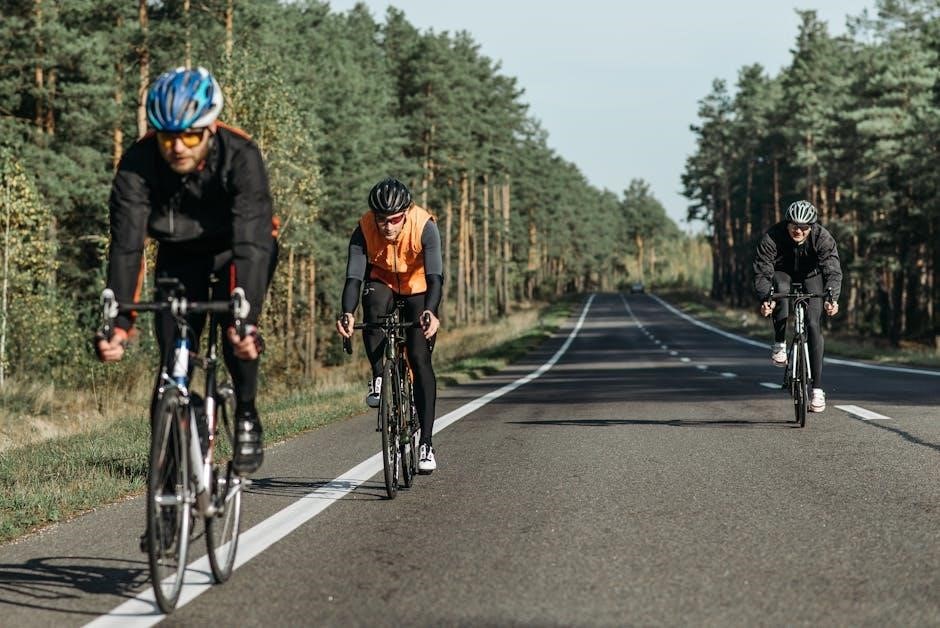
After completing a self-guided cycling trip, reflecting on the experience is crucial for personal growth and future planning; Reviewing the journey allows cyclists to assess what went well and what could be improved. Using tools like Strava and Komoot, riders can analyze ride data, such as distance, speed, and elevation, to evaluate their physical performance. Additionally, reflecting on mental health benefits, like reduced stress and increased mindfulness, can deepen the appreciation of the trip. Many cyclists also document lessons learned about gear, routes, and logistical challenges. This reflection process helps in identifying areas for improvement and inspires future adventures. By sharing insights with others, cyclists contribute to the broader cycling community, fostering collaboration and inspiration. Reflecting on the trip also provides a sense of accomplishment and closure, celebrating the unique experiences and memories made during the journey.
